Blueberry plants evolved under acidic, low-nutrient conditions. However, research and field experience have demonstrated that fertilization is necessary to achieve proper growth and high yields in cultivated production. Specific fertilization practices can vary due to differences in soil/media type, cultivar, irrigation practices, weed control, and more. In addition, the uptake of essential nutrients may be limited in certain situations (e.g., high soil pH) that must be addressed to ensure proper growth and good yields. This publication provides guidance and management suggestions to Florida growers of southern highbush blueberry (SHB) for monitoring, supplying, and maintaining proper plant nutrition in commercial production operations.
Nutrient Management
Several macro- and micronutrients are essential to the growth and development of SHB. Each is discussed below along with symptoms of deficiencies or toxicities that can impact fruit yield and quality.
Nitrogen
Nitrogen (N) is important for plant vigor, canopy and fruit growth, and the initiation and development of floral buds for the following year's crop. N deficiency symptoms include uniform paling or yellowing (chlorosis) of leaves with a reddish tinge. This is typically observed first on older leaves lower in the canopy, which can lead to fall-type colors, defoliation, and a reduction in yield in severe cases. A deficiency can also limit shoot and cane growth. Excessive amounts of N can lead to excessive vegetative growth with larger, dark green leaves, sometimes accompanied by smaller, later-ripening berries and lower yields.
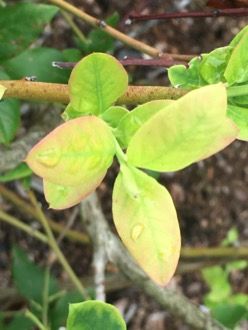
Credit: Doug Phillips, UF/IFAS
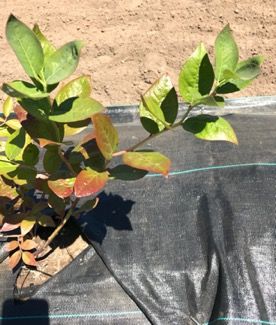
Credit: Bernadine Strik, Oregon State University
Common sources of N in blueberry fertilizers include ammonium sulfate, urea, mono- and diammonium phosphate, and different forms of organic nitrogen. Blueberries prefer the ammonium form of N to the nitrate form, although if soil pH does not exceed 5.5, small amounts of nitrate can be used as part of a fertilizer blend with ammonium. Fertilizers with only (or primarily) the nitrate form of N should not be used in conventional blueberry production. Ammonium sulfate is frequently used because the ammonium uptake assists in maintaining soil pH in the proper range, but caution should be exercised if the pH approaches the lower end of the recommended range.
Phosphorus
Phosphorus (P) is involved in root growth and is important for plant energy transfer processes. Soil tests should be performed prior to planting to determine whether an application of P is required. In planted fields, most growers apply P via a complete fertilizer.
Although not common, P deficiency has been observed in deep sandy soils and pine bark media in Florida. Symptoms can include stunted growth with small leaves, and a dark green or purple discoloration of foliage at the leaf margins. Plants growing in soils high in P may still exhibit P deficiency because this element is not mobile in the soil. Where deficient, P is typically applied as superphosphate, monoammonium phosphate, or diammonium phosphate. Note that high soil P levels may sometimes inhibit plant iron uptake, which can induce iron deficiency.
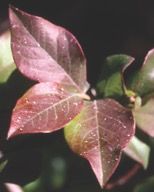
Credit: Eric Hanson, MSU Horticulture Dept.
Potassium
Potassium (K) is involved in photosynthesis and regulation of water in the plant. It is often delivered to blueberry plants as potassium sulfate, although some growers have used potassium chloride (muriate of potash). Although potassium chloride is an inexpensive source of K, blueberries are sensitive to chloride, and it may damage blueberry roots in soils with high chloride content.
K deficiency symptoms can appear similar to drought damage (marginal leaf burn), along with leaf cupping, interveinal chlorosis, and tip dieback. Drought, poorly drained soils, heavy fruit loads, and low soil pH can contribute to K deficiency.
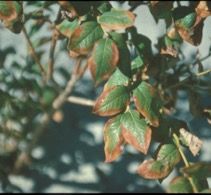
Credit: Eric Hanson, MSU Horticulture Dept.
Magnesium
Magnesium (Mg) is involved in many important plant processes. Mg deficiency can be fairly common in blueberry production due to a high calcium content in some Florida irrigation water (calcium and magnesium compete for plant uptake). Deficiency symptoms are characterized by the yellowing or reddening of areas between the primary lateral veins on leaves, with the middle of the leaf remaining green in a Christmas tree pattern. Symptoms typically appear first on older leaves. Mg deficiency can be treated by the application of magnesium sulfate or hydrated dolomitic lime, although dolomitic lime should only be used when soil pH in the root zone is below the recommended range.
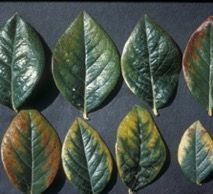
Credit: Eric Hanson, MSU Horticulture Dept.

Credit: Eric Hanson, MSU Horticulture Dept.
Calcium
Blueberries do not require a significant amount of calcium (Ca), and Ca deficiency is not typically seen. Deficiencies may occur if pH is below the recommended range and may impact fruit quality.
Micronutrients
Micronutrients important for blueberry production include iron, manganese, zinc, copper, and boron, although these elements are only required in small amounts. Deficiencies can result in reductions in plant growth, yield, and fruit quality. Micronutrient deficiencies can be determined by both observation of related symptoms and leaf analyses, and are often treated with foliar spray applications of the deficient nutrients. Deficiencies may indicate a pH outside the recommended range, or root zone conditions that adversely affect root health or function (e.g., poor drainage), both of which must be corrected to resolve the underlying cause of the deficiency.
Iron
Symptoms of iron (Fe) deficiency include yellowing (chlorosis) between the leaf veins, with the main and many minor veins remaining green. These symptoms typically appear first in the youngest leaves near the shoot tips. Leaf size and shoot growth may also be reduced. Fe may be present in the soil in sufficient quantities but unavailable for plant uptake at higher soil pH levels. In addition, poorly drained soils can result in root injury that may result in Fe deficiency. Fe deficiency can be managed by maintaining or adjusting soil pH to an appropriate level, providing for adequate bed drainage, and applying foliar sprays of an iron chelate product when significant deficiency symptoms are observed.
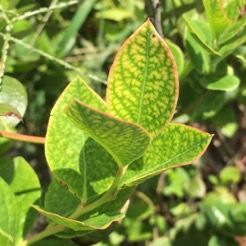
Credit: Doug Phillips, UF/IFAS
Manganese
Deficiencies in manganese (Mn) are not typically seen in blueberries. Where a deficiency exists, it can be characterized by shoot dieback, interveinal chlorosis of leaves, and necrotic areas along the leaf margin in severe cases. Pine bark contains Mn, which, along with low pH, can lead to high Mn levels and in some cases Mn toxicity, which may in turn lead to Ca deficiency. Certain fungicides contain Mn and can increase levels of Mn on leaf surfaces, possibly leading to artificially high levels from leaf analysis reports.
Zinc
Zinc (Zn) deficiency is not commonly seen in blueberries. Deficiency symptoms include small leaves and short stem internodes. There may also be some uniform chlorosis and folding of young leaves.
Copper
Copper (Cu) deficiency is rarely observed in blueberries. When present, symptoms include interveinal yellowing and dieback of young shoots.
Boron
Deficiencies in Boron (B) are not commonly observed in Florida blueberries. Symptoms include a mottled yellowing and cupping of leaves and shoot tip dieback.
Soil Testing and Leaf Analysis
Soil testing and leaf analysis are essential for determining current fertilizer needs and evaluating the efficacy of fertilizer programs and management practices.
Soil sampling should be conducted before planting to evaluate pH, organic matter content, and nutrient levels. Adjustments to these items can be made more easily before planting begins. Soil tests can also provide guidance as to whether a proposed site is suited for blueberry production. Soil testing should continue on a regular schedule after planting, especially to determine pH and salinity levels. Recommended sampling techniques should be used to collect representative samples and allow for comparisons with the prior year's data. The same laboratory should be used because different labs may use different protocols; use of the same lab will ensure that results are comparable across years. Proper techniques can be obtained from the UF/IFAS Soil Testing Laboratory (http://soilslab.ifas.ufl.edu/ESTL%20Tests.asp) and local UF/IFAS County Extension offices.
Leaf nutrient analysis should be performed at least annually. In conjunction with soil testing, leaf analysis can provide a comprehensive picture of the status of plant nutrition. Leaf analyses are often used to help diagnose a suspected nutrient deficiency. However, their main use is to assist growers in developing or adjusting fertilization programs, as well as to show longer-term trends in plant nutrition. Sufficiency ranges for nutrients for highbush blueberry are listed in Table 1.
Leaf samples should be collected by cultivar from mature, fully expanded leaves from the current season's growth, representing an area no larger than 10 acres with one soil type and the same fertilization and irrigation program. Annual samples should ideally be taken following harvest but before hedging, although growers often collect multiple samples in a year, including when symptoms of possible nutrient deficiency or toxicity appear. Residual amounts of certain elements (e.g., from fungicides or other products containing these elements) can sometimes skew analysis results.
Florida Soils and Pine Bark Beds
Florida's sandy soils are low in organic matter, and generally have a pH level in excess of that required for good blueberry growth, health, and the uptake of certain nutrients (the recommended pH range for blueberries is 4.5–5.5). Most commercial growers in Florida plant SHB either directly into raised beds of milled pine bark or into soil beds that have been amended with pine bark. The pine bark provides organic matter and a lower-pH media for good SHB growth, although it has marginal water and nutrient holding capacities. The effects of pine bark growing media must be considered when developing a fertilizer program.
Fertilization Practices
Blueberries have shallow root systems with no root hairs, limiting water and nutrient uptake ability, and the roots are typically restricted to the raised bed in pine bark systems. In addition, pine bark beds or sandy soils have low nutrient holding capacities, allowing for leaching of fertilizer below the root zone during times of heavy rainfall or irrigation. Therefore, more frequent applications of smaller volumes of fertilizer are typically more efficient and effective than larger single applications. In addition, new pine bark can immobilize the ammonium form of N, leaving an insufficient amount available for uptake by the plants. Growers should consider applying N to new bark beds at least three months prior to planting, or increasing the rate of N when new bark has been added to existing beds, because decomposition of fresh bark utilizes N that would otherwise be available for plant uptake.
Proper fertilization is essential for maximum growth and low mortality in young blueberry plants. Frequent light applications (such as with fertigation) should be made (or controlled-release fertilizers can be used) to avoid burning young plants and leaching fertilizer below the root zone. A 2017 study found that a significant portion of N allocated to flower and fruit development in young SHB (1–2 years old) came from the remobilization of N stored in roots and stems, so there was little N uptake from March through May. The highest uptake of N took place from late summer through the middle of fall. This led to the conclusion that spring fertilization requirements of young SHB may be minimal, and N uptake appears to be most efficient from fertilizer applications in summer through early fall.
As the plants mature, the goal of fertilization is to achieve a good balance between vegetative and reproductive growth to help obtain high fruit yield and quality. The number of fertilizer applications per year in Florida will typically be greater than in other areas due to long growing seasons, soils/media with poor nutrient-retention characteristics, and abundant rainfall. Many variables impact the rate and frequency of fertilizer applications, including planting density, current plant needs, type and condition of growing media, season, and levels of precipitation and irrigation. It can be difficult to accurately determine a plant's need for N fertilizer, because a portion of the N absorbed by the plant in one year can be retained for use in the following year. Also, some growers decrease the amount of N applied during the period when fruit is ripening. Decisions on fertilizer application should be made based on soil and leaf nutrient analysis, levels of plant growth and development, environmental conditions, and grower experience.
There is currently no published data on fertilizer applications for SHB grown in an evergreen production system. One of the primary differences from a deciduous system is that some level of fertilization must continue from October through December (when many growers in deciduous systems do not fertilize) to sustain the foliage on the plants through the following spring harvest.
Fertilizer types include dry granular fertilizer and liquid fertilizer (used in fertigation and foliar applications). Granular fertilizers are available in regular, slow-release, and controlled-release forms. Regular granular fertilizer is typically less expensive but persists for less than a month in pine bark. Slow-release fertilizers are higher in price, but they can last for up to 60 days. Controlled-release materials are the most expensive but will typically last between three and six months, depending on fertilizer type and soil temperature. Growers sometimes use combinations of these granular fertilizer types, along with liquid fertilizer. Fertilizer placement is especially important, because blueberry plants are salt sensitive and shallow-rooted. Dry fertilizers should be broadcast or applied evenly to the area above the root zone, avoiding clumping or concentration in a small area, and the rate should be carefully monitored to prevent root injury. For young plants, fertilizer should be applied evenly to a circular area 12 to 18 inches in diameter. Never concentrate dry fertilizer near the crowns of plants.
Fertigation is primarily used where there are drip or microjet irrigation systems in place, although some growers use overhead irrigation to apply liquid fertilizer. Some growers with drip irrigation systems cover the beds with weed mat, which is not conducive to the application of dry fertilizer. With fertigation, there is a higher degree of control over fertilizer placement and a lower chance for leaching losses when small amounts of liquid fertilizer are applied more frequently. See EDIS publication HS1197, How to Calculate Fertigation Injection Rates for Commercial Blueberry Production (https://edis.ifas.ufl.edu/hs1197).
Foliar application is used to directly supply nutrients to plant tissues, typically when certain micronutrient deficiencies exist. This can quickly provide nutrients to the plant where there is a significant deficiency and where soil conditions may be tying up nutrients. It is not an efficient method of applying N to blueberry plants. Due to higher costs and the need for repeated applications, foliar sprays should be used to supplement regular fertilization, not as a substitute for granular fertilizer or fertigation.
References
Bailey, J. S. 1941. "The Effect of Lime Applications on Growth of Cultivated Blueberry Plants." Proc. Amer. Soc. Hort. Sci. 38: 465–467.
Eck, P. 1988. Blueberry Science. Rutgers, The State University, Rutgers University Press, New Brunswick, N.J.
Hanson, E. 2016. Managing the Nutrition of Highbush Blueberries. E2011. East Lansing: Michigan State University Extension. https://www.canr.msu.edu/resources/managing_the_nutrition_of_highbush_cranberries_e2011
Hart, J., B. Strik, L. White, and W. Yang. 2006. Nutrient Management for Blueberries in Oregon. EM 8918. Corvallis: Oregon State University Extension Service. https://catalog.extension.oregonstate.edu/sites/catalog/files/project/pdf/em8918.pdf
Himelrick, D. G., A. A. Powell, and W. A. Dozier Jr. 1995. Commercial Blueberry Production Guide for Alabama. ANR-904. Auburn: Alabama Cooperative Extension System. https://ssl.acesag.auburn.edu/pubs/docs/A/ANR-0904/ANR-0904-archive.pdf
Holms, R. S. 1960. "Effect of Phosphorus and pH on Iron Chlorosis of the Blueberry in Water Culture." Soil Sci. 90: 374–379.
Krewer, G., and D. S. NeSmith. 2004. Blueberry Fertilization in Soil. University of Georgia Extension Fruit Publication 01-1. Southern Region Small Fruit Consortium. https://smallfruits.org/files/2019/06/blueberryfert.pdf
Krewer, G., S. Myers, P. Benetrand, D. Horton, S. Brown, and M. Austin. 1989. Commercial Blueberry Culture. Coop. Ext. Serv. Cir 713. Athens, GA: University of Georgia.
Mikkelsen, D. S., and C. A. Doehlert. 1950. "Magnesium Deficiency in Blueberry." Proc. Amer. Soc. Hort. Sci. 55: 289–292.
Patten, K. 1986. "Blueberry Fertigation." In T. Menges, K. Patten, C. Lyons and E. Neuendorff. Texas Blueberry Handbook. College Station: Texas Agr. Extension Service/Texas Agr. Experiment Station, Texas A&M University.
Pritts, M. P., and J. F. Hancock, eds. 1992. Commercial Blueberry Production Guide. Ithaca, NY: Northeast Regional Agricultural Engineering Service, Cooperative Extension Service.
Retamales, J. B., and J. F. Hancock. 2012. Blueberries. Cambridge, MA: CAB International.
Strik, B., G. Fisher, J. Hart, R. Ingram, D. Kaufman, R. Penhallegon, J. Pscheidt, R. Williams, C. Brun, Ahmedullah, A. Antonelli, L. Askham, P. Bristow, D. Havens, B. Scheer, C. Shanks, and D. Barney. 1993. Highbush Blueberry Production. PNW215. Corvallis: Oregon State University Extension.
Williamson, J. G., and E. P. Miller. 2009. "Effects of Fertilizer Rate and Form on Vegetative Growth and Yield of Southern Highbush Blueberry in Pine Bark Culture." HortTechnology 19 (1): 152–157.
Williamson, J. G., and P. M. Lyrene. 1995. Commercial Blueberry Production in Florida. SP179. Gainesville: University of Florida Institute of Food and Agricultural Sciences.
Yang, F., J. Williamson, R. Darnell, Y. Li, and G. Liu. 2017. "Nitrogen Uptake and Allocation at Different Growth Stages of Young Southern Highbush Blueberry Plants." HortScience 52 (6): 905–909.